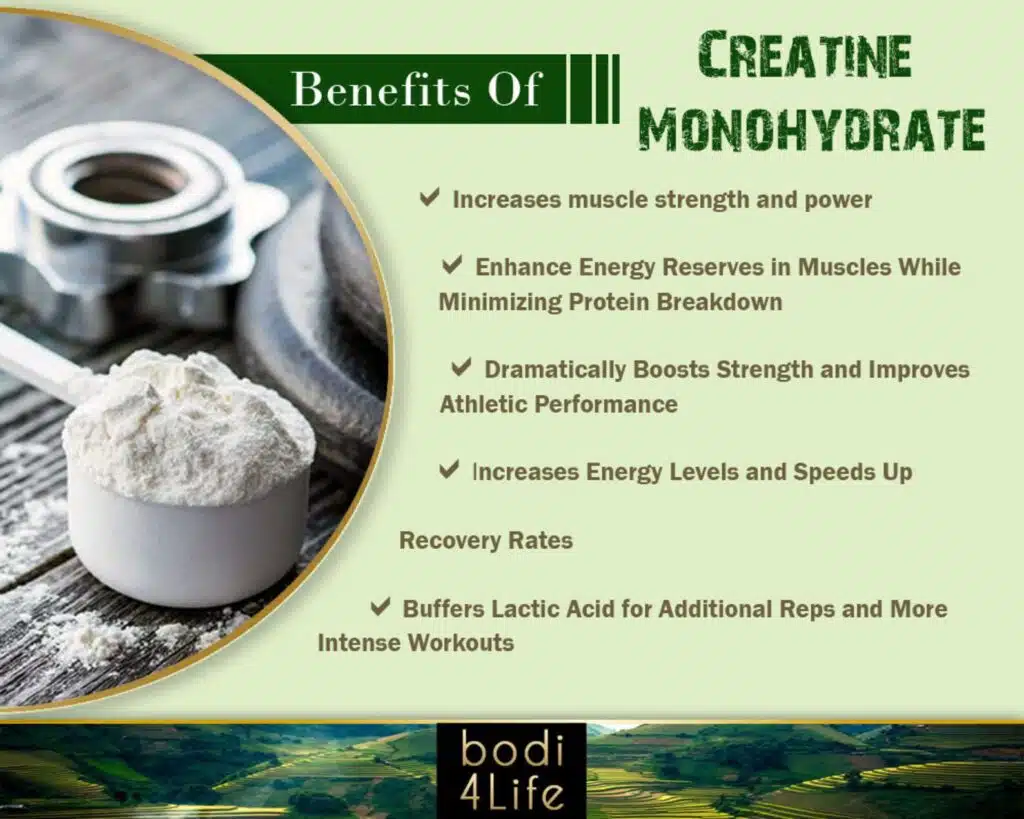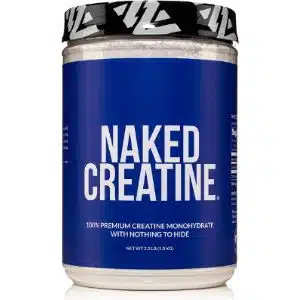Creatine is a naturally occurring organic acid found in muscle cells that helps to provide ATP to the muscles during high intensity training and heavy lifting. It is one of the most heavily researched and safest supplements for increasing strength, power, and lean muscle mass. You have likely heard a lot of hype about creatine monohydrate, but what makes it so effective? Consistent creatine supplementation over time over time increases phosphocreatine stores in muscle cells. This aids the body with more readily available ATP to be utilized during exercise. The more ATP stores we have in our muscle cells, the higher the training workload we can handle, in addition to increasing the amount of weight that we can lift.
Athletes that are involved in explosive sports like sprinting also notice better times due to increased explosiveness. Why is this? Inside the body exists the Pcr(phosphocreatine) system that is our bodies predominant source of energy for the first 10 seconds of high intensity exercise. As we increase our ATP stores via creatine supplementation, we’ll often notice increased bursts of speed during a 40-yard dash, or increased weight lifted during a 1-3 rep max squat, for example.
In terms of aesthetics, creatine pulls water into the muscle cells, resulting in fuller and denser muscles. It is also notable that there is an increase in the amount of hormones responsible for building muscle with creatine monohydrate supplementation. As we put on more muscle mass, our metabolism increases. This is because muscle weighs more than fat, and is metabolically active. As a result, creatine acts as an indirect fat burner.
How Much Creatine Should You Take?
There are 2 different methods for saturating your muscle cells with creatine. The first method is what is called a loading phase, where you take 20-25 grams(4-5 scoops a day), which will saturate muscle cells within a week. The other method is to simply take one 5-gram scoop per day, which will take roughly a month to saturate muscle cells. As for which method is better, it depends. If you want to experience increased muscle, strength, and athletic gains faster, employ the loading phase. Just be aware that you WILL put on water weight with creatine supplementation, so if you’d rather put on that water weight more slowly, then employ the second option.
As for the amount of weight gain with creatine, most research states that it is between 4-6 lbs. This is what I experience during creatine supplementation. * It is crucial that you consume enough water when supplementing with creatine, as thirst usually increases since water is drawn into the muscles. Whatever amount of water you are drinking before starting supplementation, increase that amount and see how your body reacts.*
How Creatine Prevents Muscle Breakdown
Creatine supplementation can reduce the inflammatory response of muscles post exercise, which reduces markers of muscle damage and soreness for up to 3 days after exercise-induced muscle damage. Creatine has been proven to increase muscle protein synthesis, which is essentially the muscular repair and rebuilding process after creating muscular micro trauma. The more muscle protein synthesis is optimized, the more likely that optimal recovery will kick in faster, thus leading to more muscle growth. Lastly, creatine supplementation boosts the production of anabolic hormones such as testosterone and insulin- like growth factor(IGF-1).

Benefits on the Brain
There is numerous amounts of evidence in literature to point towards creatine improving cognitive functioning in the brain. ATP is needed for neurons to secrete neurotransmitters that play a role in cell-to-cell communication within the brain and body(Fundaro, 2023). In a majority of cases, creatine supplementation increases creatine and phosphocreatine concentrations by up to 6-9% in the brains of adults and elderly individuals(Fundaro, 2023). It was also found that creatine improved short term memory of healthy elderly individuals(Fundaro, 2023).
The brains energy reserves and demands are decreased as sleep deprivation, mental fatigue, and low oxygen environments set in. When the brain lacks proper oxygen, its cells don’t provide enough ATP. This can affect the brains ability to think quickly. When supplementing with creatine, neuronal functioning, working memory, attention, and cognitive functioning may all be preserved for more complex tasks.
Due to creatine’s nature to act as an antioxidant and reserve energy, it has been suggested by research that it can increase the effects of medication used to enhance depression. There have been some promising results that show that there may be enhanced communication between brain cells(Fundaro, 2023). It is particularly women with severe depressive disorder and bipolar individuals that seem to show improvements upon adding creatine to their prescription treatments(Fundaro, 2023).
Different Types of Creatine
Aside from creatine monohydrate, there are 5 other known forms of creatine.
1. Creatine hydrochloride:
This is arguably the next most popular form of creatine. Although it has yet to be tested, it is assumed that a lower dosage can be used, thus reducing stomach related symptoms compared to the monohydrate form. This is because its reported to have superior solubility levels. Also, many users report putting on less water weight when supplementing with creatine hydrochloride.
2. Creatine ethyl ester:
Like with creatine hydrochloride, some evidence suggests that ethyl ester may be better absorbed in the body than the monohydrate form. However, there was a study that directly compared the two, and it was found that this form was worse at increasing creatine content in the blood and muscles as opposed to monohydrate(Spillane et. al, 2009).
3. Creatine magnesium chelate:
This form of creatine is chelated with magnesium, hence the name. There was a study that compared bench press strength in groups that supplemented with monohydrate, magnesium chelate, and Both groups supplementing with creatine forms improved their bench press strength more than the placebo group, but more research is needed on this form of creatine.
4. Buffered creatine:
In order to improve its stability, some manufacturing companies have added an alkaline powder to creatine, which results in a buffered form. This buffered form can also help mitigated cramping and bloating. A study directly comparing buffered and monohydrate forms found that the former wasn’t any more effective than the ladder(Jagim et. al, 2012).
5. Liquid creatine:
There are some ready to drink versions that already have creatine dissolved in water. However, studies show that liquid creatine is less effective, as it breaks down when remaining in liquid for up to several days(Harris et. al, 2004). It should be noted that creatine doesn’t break down if you mix it in water soon before use.
Side Effects of Creatine Supplementation
Side effects of creatine in certain people include:
- Kidney problems
- Inhalation problems
- Fever
- Anxiety
- Nausea
- Headaches
- Weight gain
- Diarrhea
- Rashes
The groups of people that are better off avoiding creatine are women that are pregnant or breastfeeding, those with kidney issues, and those who are diabetic and hypertensive. Lastly, those who take certain medications, such as diuretics, may experience side effects from creatine.
Kidney and liver damage remain the top concern with creatine supplementation. This is due to many users having higher levels of creatinine in their urine, which is commonly thought to be a result of kidney problems. However, it has not been proven by research that creatine damages the kidneys. Do keep in mind that the kidneys will need to work harder to excrete the excess creatinine from the whole body. This is why it is crucial that you consume enough water to help flush out the extra creatine.
For those that struggle with vomiting and nausea, switching over to a micronized form of creatine with no additional ingredients should help to fix these issues. This means looking for pure creatine monohydrate with nothing to hide, just like Naked Nutrition’s creatine monohydrate.
Final thoughts on creatine
In many peoples personal experience, creatine definitely works. While most people have only supplemented with the monohydrate form, their lean muscle mass, strength, and overall endurance undoubtedly increase when supplementing with it. It is normal to supplement with creatine for around 3-5 months, then cycle off of it for a few months. This is so that people can lose the water weight and look a bit leaner again, but this is a personal preference. You do not need to cycle on and off of creatine if you’re a healthy individual. Some people naturally benefit from creatine more so than others, as those who already eat a lot of meat may not notice much if any benefit. This is due to meat itself containing decent amounts of creatine.
If you’re worried about having to spend a lot of money on creatine monohydrate, there’s actually an extremely affordable brand of creatine monohydrate by Naked Nutrition. There is one one ingredient: pure creatine monohydrate, with nothing to hide. A 2.2 lb. tub contains a whopping 200 servings for only $35.19. Talk about a steal! The link is below if you are interested.
https://shareasale.com/r.cfm?b=1595446&u=3694395&m=78253&urllink=&afftrack=



